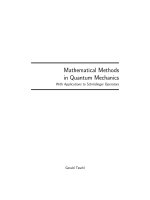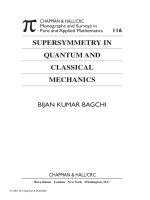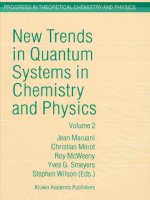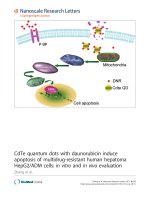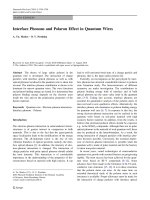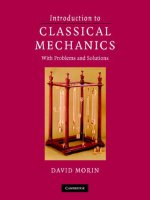- Trang chủ >>
- Khoa Học Tự Nhiên >>
- Vật lý
Supersymmetry in quantum and classical mechanics
Bạn đang xem bản rút gọn của tài liệu. Xem và tải ngay bản đầy đủ của tài liệu tại đây (1.72 MB, 224 trang )
CHAPMAN & HALL/CRC
Monographs and Surveys in
Pure and Applied Mathematics
SUPERSYMMETRY IN
QUANTUM AND
CLASSICAL
MECHANICS
BIJAN KUMAR BAGCHI
CHAPMAN & HALL/CRC
Boca Raton London New York Washington, D.C.
© 2001 by Chapman & Hall/CRC
116
Library of Congress Cataloging-in-Publication Data
Bagchi, B. (Bijan Kumar)
Supersymmetry in quantum and classical mechanics / B. Bagchi.
p. cm.-- (Chapman & Hall/CRC monographs and surveys in pure and applied mathematics)
Includes bibliographical references and index.
ISBN 1-58488-197-6 (alk. paper)
1. Supersymmetry. I. Title. II. Series.
QC174.17.S9 2000
539.7′25 --dc21
00-059602
This book contains information obtained from authentic and highly regarded sources. Reprinted material
is quoted with permission, and sources are indicated. A wide variety of references are listed. Reasonable
efforts have been made to publish reliable data and information, but the author and the publisher cannot
assume responsibility for the validity of all materials or for the consequences of their use.
Neither this book nor any part may be reproduced or transmitted in any form or by any means, electronic
or mechanical, including photocopying, microfilming, and recording, or by any information storage or
retrieval system, without prior permission in writing from the publisher.
The consent of CRC Press LLC does not extend to copying for general distribution, for promotion, for
creating new works, or for resale. Specific permission must be obtained in writing from CRC Press LLC
for such copying.
Direct all inquiries to CRC Press LLC, 2000 N.W. Corporate Blvd., Boca Raton, Florida 33431.
Trademark Notice: Product or corporate names may be trademarks or registered trademarks, and are
used only for identification and explanation, without intent to infringe.
© 2001 by Chapman & Hall/CRC
No claim to original U.S. Government works
International Standard Book Number 1-58488-197-6
Library of Congress Card Number 00-059602
Printed in the United States of America 1 2 3 4 5 6 7 8 9 0
Printed on acid-free paper
© 2001 by Chapman & Hall/CRC
www.pdfgrip.com
For Basabi and Minakshi
© 2001 by Chapman & Hall/CRC
www.pdfgrip.com
Contents
Preface
Acknowledgments
1 General Remarks on Supersymmetry
1.1 Background
1.2 References
2 Basic Principles of SUSYQM
2.1 SUSY and the Oscillator Problem
2.2 Superpotential and Setting Up a Supersymmetric Hamiltonian
2.3 Physical Interpretation of Hs
2.4 Properties of the Partner Hamiltonians
2.5 Applications
2.6 Superspace Formalism
2.7 Other Schemes of SUSY
2.8 References
3 Supersymmetric Classical Mechanics
3.1 Classical Poisson Bracket, its Generalizations
3.2 Some Algebraic Properties of the Generalized Poisson
Bracket
3.3 A Classical Supersymmetric Model
3.4 References
4 SUSY Breaking, Witten Index, and Index Condition
4.1 SUSY Breaking
4.2 Witten Index
© 2001 by Chapman & Hall/CRC
www.pdfgrip.com
4.3
4.4
4.5
4.6
4.7
4.8
4.9
4.10
4.11
Finite Temperature SUSY
Regulated Witten Index
Index Condition
q-deformation and Index Condition
Parabosons
Deformed Parabose States and Index Condition
Witten’s Index and Higher-Derivative SUSY
Explicit SUSY Breaking and Singular Superpotentials
References
5 Factorization Method, Shape Invariance
5.1 Preliminary Remarks
5.2 Factorization Method of Infeld and Hull
5.3 Shape Invariance Condition
5.4 Self-similar Potentials
5.5 A Note On the Generalized Quantum Condition
5.6 Nonuniqueness of the Factorizability
5.7 Phase Equivalent Potentials
5.8 Generation of Exactly Solvable Potentials in SUSYQM
5.9 Conditionally Solvable Potentials and SUSY
5.10 References
6 Radial Problems and Spin-orbit Coupling
6.1 SUSY and the Radial Problems
6.2 Radial Problems Using Ladder Operator Techniques
in SUSYQM
6.3 Isotropic Oscillator and Spin-orbit Coupling
6.4 SUSY in D Dimensions
6.5 References
7 Supersymmetry in Nonlinear Systems
7.1 The KdV Equation
7.2 Conservation Laws in Nonlinear Systems
7.3 Lax Equations
7.4 SUSY and Conservation Laws in the KdV-MKdV
Systems
7.5 Darboux’s Method
7.6 SUSY and Conservation Laws in the KdV-SG Systems
7.7 Supersymmetric KdV
© 2001 by Chapman & Hall/CRC
www.pdfgrip.com
7.8
7.9
Conclusion
References
8 Parasupersymmetry
8.1 Introduction
8.2 Models of PSUSYQM
8.3 PSUSY of Arbitrary Order p
8.4 Truncated Oscillator and PSUSYQM
8.5 Multidimensional Parasuperalgebras
8.6 References
Appendix A
Appendix B
© 2001 by Chapman & Hall/CRC
www.pdfgrip.com
Preface
This monograph summarizes the major developments that have taken
place in supersymmetric quantum and classical mechanics over the
past 15 years or so. Following Witten’s construction of a quantum
mechanical scheme in which all the key ingredients of supersymmetry are present, supersymmetric quantum mechanics has become a
discipline of research in its own right. Indeed a glance at the literature on this subject will reveal that the progress has been dramatic.
The purpose of this book is to set out the basic methods of supersymmetric quantum mechanics in a manner that will give the reader
a reasonable understanding of the subject and its applications. We
have also tried to give an up-to-date account of the latest trends in
this field. The book is written for students majoring in mathematical science and practitioners of applied mathematics and theoretical
physics.
I would like to take this opportunity to thank my colleagues
in the Department of Applied Mathematics, University of Calcutta
and members of the faculty of PNTPM, Universite Libre de Bruxeles, especially Prof. Christiane Quesne, for their kind cooperation.
Among others I am particularly grateful to Profs. Jules Beckers,
Debajyoti Bhaumik, Subhas Chandra Bose, Jayprokas Chakrabarti,
Mithil Ranjan Gupta, Birendranath Mandal, Rabindranath Sen, and
Nandadulal Sengupta for their interest and encouragement. It also
gives me great pleasure to thank Prof. Rajkumar Roychoudhury and
Drs. Nathalie Debergh, Anuradha Lahiri, Samir Kumar Paul, and
Prodyot Kumar Roy for fruitful collaborations. I am indebted to my
students Ashish Ganguly and Sumita Mallik for diligently reading
the manuscript and pointing out corrections. I also appreciate the
help of Miss Tanima Bagchi, Mr. Dibyendu Bose, and Dr. Mridula
© 2001 by Chapman & Hall/CRC
www.pdfgrip.com
Kanoria in preparing the manuscript with utmost care. Finally, I
must thank the editors at Chapman & Hall/CRC for their assistance
during the preparation of the manuscript. Any suggestions for improvement of this book would be greatly appreciated.
I dedicate this book to the memory of my parents.
Bijan Kumar Bagchi
© 2001 by Chapman & Hall/CRC
www.pdfgrip.com
Acknowledgments
This title was initiated by the International Society for the Interaction of Mechanics and Mathematics (ISIMM). ISIMM was established in 1975 for the genuine interaction between mechanics and
mathematics. New phenomena in mechanics require the development of fundamentally new mathematical ideas leading to mutual
enrichment of the two disciplines. The society fosters the interests of
its members, elected from countries worldwide, by a series of biannual international meetings (STAMM) and by specialist symposia
held frequently in collaboration with other bodies.
© 2001 by Chapman & Hall/CRC
www.pdfgrip.com
CHAPTER 1
General Remarks on
Supersymmetry
1.1
Background
It is about three quarters of a century now since modern quantum mechanics came into existence under the leadership of such
names as Born, de Broglie, Dirac, Heisenberg, Jordan, Pauli, and
Schroedinger. At its very roots the conceptual foundations of quantum theory involve notions of discreteness and uncertainty.
Schroedinger and Heisenberg, respectively, gave two distinct but
equivalent formulations: the configuration space approach which deals
with wave functions and the phase space approach which focuses on
the role of observables. Dirac noticed a connection between commutators and classical Poisson brackets and it was chiefly he who gave
the commutator form of the Poisson bracket in quantum mechanics
on the basis of Bohr’s correspondence principle.
Quantum mechanics continues to attract the mathematicians
and physicists alike who are asked to come to terms with new ideas
and concepts which the tweory exposes from time to time [1-2]. Supersymmetric quantum mechanics (SUSYQM) is one such area which
has received much attention of late. This is evidenced by the frequent appearances of research papers emphasizing different aspects
of SUSYQM [3-9]. Indeed the boson-fermion manifestation in soluble
models has considerably enriched our understanding of degeneracies
© 2001 by Chapman & Hall/CRC
www.pdfgrip.com
and symmetry properties of physical systems.
The concept of supersymmetry (SUSY) first arose in 1971 when
Ramond [10] proposed a wave equation for free fermions based on
the structure of the dual model for bosons. Its formal properties
were found to preserve the structure of Virasoro algebra. Shortly
after, Neveu and Schwarz [11] constructed a dual theory employing
anticommutation rules of certain operators as well as the ones conforming to harmonic oscillator types of the conventicnal dual model
for bosons. An important observation made by them was that such
a scheme contained a gauge algebra larger than the Virasoro algebra
of the conventional model. It needs to be pointed out that the idea
of SUSY also owes its origin to the remarkable paper of Gol’fand and
Likhtam [12] who wrote down tne four-dimensional Poincare superalgebra. Subsequent to these works various models embedding SUSY
were proposed within a field-theoretic framework [13-14]. The most
notable one was the work of Wess and Zumino [14] who defined a
set of supergauge transformation in four space-time dimensions and
pointed out their relevance to the Lagrangian free-field theory. It
has been found that SUSY field theories prove to be the least divergent in comparison with the usual quantum field theories. From a
particle physics point of view, some of the major motivations for the
study of SUSY are: (i) it provides a convenient platform for unifying
matter and force, (ii) it reduces the divergence of quantum gravity,
and (iii) it gives an answer to the so-called “hierarchy problem” in
grand unified theories.
The basic composition rules of SUSY contain both commutators
and anticommutators which enable it to circumvent the powerful
“no-go” theorem of Coleman and Mandula [15]. The latter states
that given some basic features of S-matrix (namely that only a finite number of different particles are associated with one-particle
states and that an energy gap exists between the vacuum and the
one-particle state), of all the ordinary group of symmetries for the
S-matrix based on a local, four-dimensional relativistic field theory,
the only allowed ones are locally isomorphic to the direct product
of an internal symmetry group and the Poincare group. In other
words, the most general Lie algebra structure of the S-matrix contains the energy-momentum operator, the rotation operator, and a
finite number of Lorentz scalar operators.
© 2001 by Chapman & Hall/CRC
www.pdfgrip.com
Some of the interesting features of a supersymmetric theory may
be summarized as follows [16-28]:
1. Particles with different spins, namely bosons and fermions, may
be grouped together in a supermultiplet. Consequently, one
works in a framework based on the superspace formalism [16].
A superspace is an extension of ordinary space-time to the one
with spin degrees of freedom. As noted, in a supersymmetric
theory commutators as well as anticommutators appear in the
algebra of symmetry generators. Such an algebra involving
commutators and anticommutators is called a graded algebra.
2. Internal symmetries such as isospin or SU (3) may be incorporated in the supermultiplet. Thus a nontrivial mixing between
space-time and internal symmetry is allowed.
3. Composition rules possess the structure [28]
c
Xa Xb − (−)ab Xb Xa = fab
Xc
where, a, b = 0 if X is an even generator, a, b = 1 if X is an odd
c are the structure constants. We can express
generator, and fab
X as (A, S) where the even part A generates the ordinary ndimensional Lie algebra and the odd part S corresponds to the
grading representation of A. The generalized Lie algebra with
generators X has the dimension which is the sum of n and the
dimension of the representation of A. The Lie algebra part of
the above composition rule is of the form T ⊗ G where T is
the space-time symmetry and G corresponds to some internal
structure. Note that S belongs to a spinorial representation of
a homogeneous Lorentz group which due to the spin-statistics
theorem is a subgroup of T .
4. Divergences in SUSY field theories are greatly reduced. Indeed all the quadratic divergences disappear in the renormalized supersymmetric Lagrangian and the number of independent renormalization constants is kept to a minimum.
5. If SUSY is unbroken at the tree-level, it remains so to any order
of h
¯ in perturbation theory.
© 2001 by Chapman & Hall/CRC
www.pdfgrip.com
In an attempt to construct a theory of SUSY that is unbroken
at the tree-level but could be broken by small nonperturbative corrections, Witten [29] proposed a class of grand unified models within
a field theoretic framework. Specifically, he considered models (in
less than four dimensions) in which SUSY could be broken dynamically. This led to the remarkable discovery of SUSY in quantum
mechanics dealing with systems less than or equal to three dimensions. Historically, however, it was Nicolai [31] who sowed the seeds
of SUSY in nonrelativistic mechanics. Nicolai showed that SUSY
could be formulated unambiguously for nonrelativistic spin systems
by writing down a graded algebra in terms of the generators of the
supersymmetric transformations. He then applied this algebra to
the one-dimensional chain lattice problem. However, it must be said
that his scheme did not deal explicitly with any kind of superpotential and as such connections to solvable quantum mechanical systems
were not transparent.
Since spin is a well-defined concept in at least three dimensions,
SUSY in one-dimensional nonrelativistic systems is concerned with
mechanics describable by ordinary canonical and Grassmann variables. One might even go back to the arena of classical mechanics
in the realm of which a suitable canonical method can be developed by formulating generalized Poisson brackets and then setting
up a correspondence principle to derive the quantization rule. Conversely, generalized Poisson brackets can also be arrived at by taking
the classical limit of the generalized Dirac bracket which is defined
according to the “even” or “odd” nature of the operators.
The rest of the book is organized as follows.
In Chapter 2 we outline the basic principles of SUSYQM, starting with the harmonic oscillator problem. We try to give a fairly
complete presentation of the mathematical tools associated with
SUSYQM and discuss potential applications of the theory. We also
include in this chapter a section on superspace formalism. In Chapter
3 we consider supersymmetric classical mechanics and study generalized classical Poisson bracket and quantization rules. In Chapter
4 we introduce the concepts of SUSY breaking and Witten index.
Here we comment upon the relevance of finite temperature SUSY
and analyze a regulated Witten index. We also deal with index condition and the issue of q-deformation. In Chapter 5 we provide an
© 2001 by Chapman & Hall/CRC
www.pdfgrip.com
elaborate treatment on factorization method, shape invariance condition, and generation of solvable potentials. In Chapter 6 we deal
with the radial problem and spin-orbit coupling. Chapter 7 applies
SUSY to nonlinear systems and discusses a method of constructing
supersymmetric KdV equation. In Chapter 8 we address parasupersymmetry and present models on it, including the one obtained from
a truncated oscillator algebra. Finally, in the Appendix we broadly
outline a mathematical supplement on the derivation of the form of
D-dimensional Schroedinger equation.
1.2
References
[1] L.M. Ballentine, Quantum Mechanics - A Modern Development, World Scientific, Singapore, 1998.
[2] M. Chester, Primer of Quantum Mechanics, John Wiley &
Sons, New York, 1987.
[3] L.E. Gendenshtein and I.V. Krive, Sov. Phys. Usp., 28, 645,
1985.
[4] A. Lahiri, P.K. Roy, and B. Bagchi, Int. J. Mod. Phys., A5,
1383, 1990.
[5] B. Roy, P. Roy, and R. Roychoudhury, Fortsch. Phys., 39, 211,
1991.
[6] G. Levai, Lecture Notes in Physics, 427, 127, Springer, Berlin,
1993.
[7] F. Cooper, A. Khare, and U. Sukhatme, Phys. Rep., 251, 267,
1995.
[8] G. Junker, Supersymmetric Methods in Quantum and Statistical Physics, Springer, Berlin, 1996.
[9] M.A. Shifman, ITEP Lectures on Particle Physics and Field
Theory, 62, 301, World Scientific, Singapore, 1999.
[10] P. Ramond, Phys. Rev., D3, 2415, 1971.
[11] A. Neveu and J.H. Schwarz, Nucl. Phys., B31, 86, 1971.
© 2001 by Chapman & Hall/CRC
www.pdfgrip.com
[12] Y.A. Gol’fand and E.P. Likhtam, JETP Lett., 13, 323, 1971.
[13] D.V. Volkov and V.P. Akulov, Phys. Lett., B46, 109, 1973.
[14] J. Wess and B. Zumino, Nucl. Phys., B70, 39, 1974.
[15] S. Coleman and J. Mandula, Phys. Rev., 159, 1251, 1967.
[16] A. Salam and J. Strathdee, Fortsch. Phys., 26, 57, 1976.
[17] A. Salam and J. Strathdee, Nucl. Phys., B76, 477, 1974.
[18] V.I. Ogievetskii and L. Mezinchesku, Sov. Phys. Usp., 18, 960,
1975.
[19] P. Fayet and S. Ferrara, Phys. Rep., 32C, 250, 1977.
[20] M.S. Marinov, Phys. Rep., 60C, 1, (1980).
[21] P. Nieuwenhuizen, Phys. Rep., 68C, 189, 1981.
[22] H.P. Nilles, Phys. Rep., 110C, 1, 1984.
[23] M.F. Sohnius, Phys. Rep., 128C, 39, 1985.
[24] R. Haag, J.F. Lopuszanski, and M. Sohnius, Nucl. Phys., B88,
257, 1975.
[25] J. Wess and J. Baggar, Supersymmetry and Supergravity, Princeton University Press, Princeton, NJ, 1983.
[26] P.G.O. Freund, Introduction to Supersymmetry, Cambridge Monographs on Mathematical Physics, Cambridge University Press,
Cambridge, 1986.
[27] L. O’Raifeartaigh, Lecture Notes on Supersymmetry, Comm.
Dublin Inst. Adv. Studies, Series A, No. 22, 1975.
[28] S. Ferrara, An introduction to supersymmetry in particle physics, Proc. Spring School in Beyond Standard Model
Lyceum Alpinum, Zuoz, Switzerland, 135, 1982.
[29] E. Witten, Nucl. Phys., B188, 513, 1981.
[30] E. Witten, Nucl. Phys., B202, 253, 1982.
© 2001 by Chapman & Hall/CRC
www.pdfgrip.com
[31] H. Nicolai, J. Phys. A. Math. Gen., 9, 1497, 1976.
[32] H. Nicolai, Phys. Blă
atter, 47, 387, 1991.
â 2001 by Chapman & Hall/CRC
www.pdfgrip.com
CHAPTER 2
Basic Principles of
SUSYQM
2.1
SUSY and the Oscillator Problem
By now it is well established that SUSYQM provides an elegant
description of the mathematical structure and symmetry properties
of the Schroedinger equation. To appreciate the relevance of SUSY in
simple nonrelativistic quantum mechanical syltems and to see how it
works in these systems let us begin our discussion with the standard
harmonic oscillator example. Its Hamiltonian HB is given by
HB = −
2
−
h
d2
1
2 2
+ mωB
x
2
2m dx
2
(2.1)
where ωB denotes the natural frequency of the oscillator and −
h =
h
2π , h the Planck’s constant. Unless there is any scope of confusion
we shall adopt the units −
h = m = 1.
Associated with HB is a set of operators b and b+ called, respectively, the lowering (or annihilation) and raising (or creation)
d
operators [1-6] which can be defined by p = −i dx
i
(p − iωB x)
2ωB
i
= −√
(p + iωB x)
2ωB
b =
b+
√
© 2001 by Chapman & Hall/CRC
www.pdfgrip.com
(2.2)
Under (2.2) the Hamiltonian HB assumes the form
1
HB = ω B b+ , b
2
(2.3)
where {b+ , b} is the anti-commutator of b and b+ .
As usual the action of b and b+ upon an eigenstate |n > of
harmonic oscillator is given by
√
n|n − 1 >
√
+
n + 1|n + 1 >
b |n > =
b|n > =
(2.4)
The associated bosonic number operator NB = b+ b obeys
NB |n >= n|n >
(2.5)
with n = nB .
+ n
The number states are |n > (b√n!) |0 > (n = 0, 1, 2, . . .) and the
lowest state, the vacuum |0 >, is subjected to b|0 >= 0.
The canonical quantum condition [q, p] = i can be translated in
terms of b and b+ in the form
[b, b+ ] = 1
(2.6)
Along with (2.6) the following conditons also hold
[b, b] = 0,
+
b , b+
= 0
(2.7)
[b, HB ] = ωB b,
+
b , HB
= −ωB b+
(2.8)
We may utilize (2.6) to express HB as
1
1
HB = ωB (b+ b + ) = ωB NB +
2
2
(2.9)
whichfleads to the energy spectrum
EB = ω B nB +
1
2
© 2001 by Chapman & Hall/CRC
www.pdfgrip.com
(2.10)
The form (2.3) implies that the Hamiltonian HB is symmetric under
the interchange of b and b+ , indicating that the associated particles
obey Bose statistics.
Consider now the replacement of the operators b and b+ by the
corresponding ones of the fermionic oscillator. This will yield the
fermionic Hamiltonian
HF =
ωF +
a ,a
2
(2.11)
where a and a+ , identified with the lowering (or annihilation) and
raising (or creation) operators of a fermionic oscillator, satisfy the
conditions
{a, a+ } = 1,
(2.12)
+
+
{a, a} = 0, {a , a } = 0
(2.13)
We may also define in analogy with NB a fermionic number operator
NF = a+ a. However, the nilpotency conditions (2.13) restrict NF to
the eigenvalues 0 and 1 only
NF2
= (a+ a)(a+ a)
= (a+ a)
= NF
NF (NF − 1) = 0
(2.14)
The result (2.14) is in conformity with Pauli’s exclusion principle.
The antisymmetric nature of HF under the interchange of a and a+
is suggestive that we are dealing with objects satisfying Fermi-Dirac
statistics. Such objects are called fermions. As with b and b+ in (2.2),
the operators a and a+ also admit of a plausible representation. In
terms of Pauli matrices we can set
1
1
a = σ− , a+ = σ+
2
2
(2.15)
where σ± = σ1 ± iσ2 and [σ+ , σ− ] = 4σ3 . Note that
σ1 =
0
1
1
0
, σ2 =
0
i
−i
0
, σ3 =
© 2001 by Chapman & Hall/CRC
www.pdfgrip.com
1
0
0
−1
(2.16)
We now use the condition (2.12) to express HF as
HF = ω F N F −
1
2
(2.17)
1
2
(2.18)
which has the spectrum
EF = ω F nF −
where nF = 0, 1.
For the development of SUSY it is interesting to consider [7] the
composite system emerging out of the superposition of the bosonic
and fermionic oscillators. The energy E of such a system, being the
sum of EB and EF , is given by
E = ω B nB +
1
2
+ ω F nF −
1
2
(2.19)
We immediately observe from the above expression that E remains
unchanged under a simultaneous destruction of one bosonic quantum
(nB → nB −1) and creation of one fermionic quantum (nF → nF +1)
or vice-versa provided the natural frequencies ωB and ωF are set
equal. Such a symmetry is called “supersymmetry” (SUSY) and the
corresponding energy spectrum reads
E = ω(nB + nF )
(2.20)
where ω = ωB = ωF . Obviously the ground state has a vanishing
energy value (nB = nF = 0) and is nondegenerate (SUSY unbroken).
This zero value arises due to the cancellation between the boson and
fermion contributions to the supersymmetric ground-state energy.
Note that individually the ground-state energy values for the bosonic
and fermionic oscillators are ω2B and − ω2F , respectively, which can be
seen to be nonzero quantities. However, except for the ground-state,
the spectrum (2.20) is doubly degenerate.
It also follows in a rather trivial way that since the SUSY degeneracy arises because of the simultaneous destruction (or creation) of
one bosonic quantum and creation (or destruction) of one fermionic
quantum, the corresponding generators should behave like ba+ (or
b+ a). Indeed if we define quantities Q and Q+ as
√
Q =
ωb ⊗ a+ ,
√
ωb+ ⊗ a
(2.21)
Q+ =
© 2001 by Chapman & Hall/CRC
www.pdfgrip.com
it is straightforward to check that the underlying supersymmetric
Hamiltonian Hs can be expressed as
Hs = ω b+ b + a+ a
=
Q, Q+
(2.22)
and it commutes with both Q and Q+
[Q, Hs ] = 0
Q+ , Hs
= 0
(2.23)
Further,
{Q, Q} = 0
+
Q , Q+
= 0
(2.24)
Corresponding to Hs a basis in the Hilbert space composed of HB ⊗
HF is given by {|n > ⊗| 0 >F , |n > ⊗ a+ | 0 >F } where n = 0, 1, 2 . . .
and 0 >F is the fermionic vacuum.
In view of (2.23), Q and Q+ are called supercharge operators or
simply supercharges. From (2.22) - (2.24) we also see that Q, Q+ , and
Hs obey among themselves an algebra involving both commutators
as well as anti-commutators. As already mentioned in Chapter 1
such an algebra is referred to as a graded algebra.
It is now clear that the role of Q and Q+ is to convert a bosonic
(fermionic) state to a fermionic (bosonic) state when operated upon.
This may be summarised as follows
Q |nB , nF >
=
Q+ |nB , nF >
=
√
ωnB | nB − 1, nF + 1 >, nB
=,0nF
ω(nB + 1) nB + 1, nF − 1 >, nF
=1
= 0 (2.25)
However, Q+ |nB , nF >= 0 and Q|nB , nF >= 0 for the cases (nB =
0, nF = 1) and nF = 0, respectively.
To seek a physical interpretation of the SUSY Hamiltonian Hs
let us use the representations (2.2) and (2.15) for the bosonic and
fermionic operators. We find from (2.22)
Hs =
1 2
p + ω 2 x2
2
•
1
+ ωσ3
2
© 2001 by Chapman & Hall/CRC
www.pdfgrip.com
(2.26)
where ã is the (2 ì 2) unit matrix. We see that Hs corresponds to a
bosonic oscillator with an electron in the external magnetic field.
The two components of Hs in (2.26) can be projected out in a
manner
1 d2
1 2 2
+
ω x − ω ≡ ωb+ b
H+ = −
2
2 dx
2
1 d2
1 2 2
H− = −
+
ω x + ω ≡ ωbb+
(2.27a, b)
2 dx2 2
Equivalently one can express Hs as
Hs ≡
diag (H− , H+ )
1 • ω
+ σ3
= ω b+ b +
2
2
(2.28)
by making use of (2.6).
From (2.27) it is seen that H+ and H− are nothing but two realizations of the same harmonic oscillator Hamiltonian with constant
shifts ±ω in the energy spectrum. We also notice that H± are the
outcomes of the products of the operators b and b+ in direct and
reverse orders, respectively, the explicit forms being induced by the
representations (2.2) and (2.15). Indeed this is the essence of the
factorization scheme in quantum mechanics to which we shall return
in Chapter 5 to handle more complicated systems.
2.2
Superpotential and Setting Up a Supersymmetric Hamiltonian
H+ and H− being the partner Hamiltonians in Hs , we can easily
isolate the corresponding partner potentials V± from (2.27). Actually
these potentials may be expressed as
V± (x) =
1
W 2 (x) ∓ W (x)
2
(2.29)
with W (x) = ωx. We shall refer to the function W (x) as the superpotential. The representations (2.29) were introduced by Witten [8]
to explore the conditions under which SUSY may be spontaneously
broken.
The general structure of V± (x) in (2.29) is indicative of the possibility that we can replace the coordinate x in (2.27) by an arbitrary
© 2001 by Chapman & Hall/CRC
www.pdfgrip.com
function W (x). Indeed the forms (2.29) of V± reside in the following
general expression of the supersymmetric Hamiltonian
Hs =
1 2
p + W2
2
•
1
+ σ3 W
2
(2.30)
W (x) is normally taken to be a real, continuously differentiable function in . However, should we run into a singular W (x), the necessity
of imposing additional conditions on the wave functions in the given
space becomes important [10].
Corresponding to Hs , the associated supercharges can be written
in analogy with (2.21) as
Q =
Q+ =
1
√
2
1
√
2
0
0
W + ip
0
0
0
W − ip 0
(2.31)
As in (2.22), here too Q and Q+ may be combined to obtain
Hs = Q, Q+
(2.32)
Furthermore, Hs commutes with both Q and Q+
[Q, Hs ] = 0
Q+ , Hs
= 0
(2.33)
Relations (2.30) - (2.33) provide a general nonrelativistic basis
from which it follows that Hs satisfies all the criterion of a formal
supersymmetric Hamiltonian. It is obvious that these relations allow
us to touch upon a wide variety of physical systems [12-53] including
approximate formulations [54-63].
In the presence of the superpotential W (x), the bosonic operators b and b+ go over to more generalized forms, namely
√
√
d
dx
d
= W (x) −
dx
2ωb → A = W (x) +
2ωb+ → A+
(2.34)
In terms of A and A+ the Hamiltonian Hs reads
2Hs =
1
A, A+
2
ã
1
+ 3 A, A+
2
â 2001 by Chapman & Hall/CRC
www.pdfgrip.com
(2.35)
Expressed in a matrix structure Hs is diagonal
Hs ≡
=
diag (H− , H+ )
1
diag AA+ , A+ A
2
(2.36)
Note that Hs as in (2.30) is just a manifestation of (2.34). In the
literature it is customery to refer to H+ and H− as “bosonic” and
“fermionic” hands of Hs , respectively.
The components H± , however, are deceptively nonlinear since
any one of them, say H− , can always be brought to a linear form by
the transformation W = u /u. Thus for a suitable u, W (x) may be
determined which in turn sheds light on the structure of the other
component.
It is worth noting that both H± may be handled together by
taking recourse to the change of variables W = gu /u where, g,
which may be positive or negative, is an arbitrary parameter. We
see that H± acquire the forms
d2
2H± = − 2 + g 2 ± g
dx
u
u
2
∓g
u
u
(2.37)
It is clear that the parameter g effects an interchange between the
“bosonic” and “fermionic” sectors : g → −g, H+ ↔ H− . To show
how this procedure works in practice we take for illustration [64] the
superpotential conforming to supersymmetric
Liouville system [24]
√
2g
described by the superpotential W (x) = a exp ax
, g and a are
√ 2
/a2 .
parameters. Then u is given by u(x) = exp 2 2 exp ax
2
2
d
2
The Hamiltonian H+ satisfies − dx
2 + W − W
Transforming y =
becomes
√
4 2
g exp ax
2
a2
ψ+ = 2E+ ψ+ .
, the Schroedinger equation for H+
1
d2
1
1 d
8E+
ψ+
−
ψ+ +
ψ+ + 2 2 ψ+ = 0
dy 2
y dy
2g 4
a y
(2.38)
The Schroedinger equation for H− can be at once ascertained from
(2.38) by replacing g → −g which means transforming y → −y. The
relevant eigenfunctions turn out to be given by confluent hypogeometric function.
© 2001 by Chapman & Hall/CRC
www.pdfgrip.com
The construction of the SUSYQM scheme presented in (2.30) (2.33) remains incomplete until we have made a connection to the
Schroedinger Hamiltonian H. This is what we’ll do now.
Pursuing the analogy with the harmonic oscillator problem, specifically (2.27a), we adopt for V the form V = 12 W 2 − W + λ inWwhich the constant λ can be adjusted to coincide with the groundstate energy E0 oh H+ . In other words we write
V (x) − E0 =
1
W2 − W
2
(2.39)
indicating that V and V+ can differ only by the amount of the groundstate energy value E0 of H.
If W0 (x) is a particular solution, the general solution of (2.39) is
given by
W (x) = W0 (x) +
exp [2 x W0 (τ )dτ ]
, β∈R
β − x exp [2 y W0 (τ )dτ ] dy
(2.40)
On the other hand, the Schroedinger equation
−
1 d2
+ V (x) − E0 ψ0 = 0
2 dx2
(2.41)
subject to (2.39) has the solution
x
ψ0 (x) = A exp −
x
exp 2
W (τ )dτ + B exp −
y
x
W (τ )dτ
W (τ )dτ dy
(2.42)
where A, B, ∈ R and assuming ψ(x) ∈ L2 (−∞, ∞). If (2.40) is substituted in (2.42), the wave function is the same [65] whether a particular W0 (x) or a general solution to (2.39) is used in (2.42).
In N = 2 SUSYQM, in place of the supercharges Q and Q+ defined in (2.31), we can also reformulate the algebra (2.32) - (2.35) by
introducing a set of hermitean operators Q1 and Q2 being expressed
as
Q = (Q1 + iQ2 ) /2, Q+ = (Q1 − iQ2 ) /2
(2.43)
While (2.32) is converted to Hs = Q21 = Q22 that is
{Qi , Qj } = 2δij Hs
© 2001 by Chapman & Hall/CRC
www.pdfgrip.com
(2.44)
